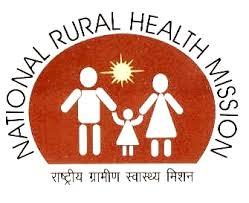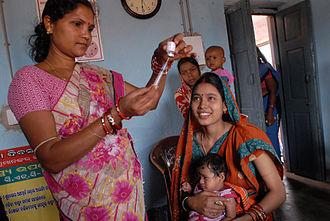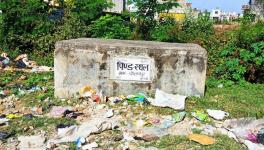Better Days Ahead – for Insurance Companies and Corporate Hospitals
Since being installed in government the BJP’s ministers have announced a slew of measures to usher in “better days”. True to this pattern, the new government’s health minister – Dr.Harsh Vardhan – has articulated a number of priorities in the health sector. None of them come as a surprise as they are true to the BJP’s core ideology of further promoting the neoliberal agenda of the previous UPA government.
What Dr.Harsh Vardhan promises now is a continuation of the BJP’s vision that it had articulated in its 2014 election manifesto, and previously in its 2009 manifesto. In 2009 the BJP’s manifesto had said that ““The BJP will launch a massive programme, through public-private participation, to introduce a ‘Health for All’ scheme based on an innovative insurance policy”. In its 2014 manifesto the party was less explicit about promoting insurance and public-private partnerships, and had instead couched its intentions with the promise that “the overarching goal of healthcare would be to provide, 'Health Assurance to all Indians…”.

Image Courtesy: en.wikipedia.org
That “health assurance” is synonymous with health insurance and public-private partnership is now clear. In one of his first interactions with the media, Dr.Harsh Vardhan is reported to have said that “the government would work to provide 'health insurancecoverage for all' through a national insurance policy for health”. He praised the UPA government’s Rashtriya Swasthya Bima Yojana (RSBY), and promised to expand it. In other interactions with the media the minister has promised to push for increased public-private partnership (PPP) and an insurance-driven health sector. Dr.Harsh Vardhan has also said that that he is “not in favour of taxpayers’ money being used to push a one-size-fits-all health policy”.
BJP’s road map for health care
These pronouncements, taken together, paint a clear picture of the road map for health care that the BJP government wishes to promote. The BJP’s vision involves an insurance based system with an increasing ‘partnership’ with the private sector. This is the same vision that the UPA government has tried to foist on the country over the past decade. The principal medium of the insurance based system for providing care, that the UPA government had promoted, was its Rashtriya Swasthya Bima Yojana (National Health Insurance Scheme) – which Dr.Harsh Vardhan now wants to expand. A partial saving grace of the UPA government’s health policy was its continued, albeit grudging, support to the National Rural Health Mission (later renamed the National Health Mission). The NRHM continued to be grossly under funded till the last days of the UPA government, with total fund allocation since its inception in 2005 being about one-third of what was initially conceived. In spite of a number of deficiencies and opposition to its full implementation from within the UPA government (including from powerful interests within the Planning Commission), the NRHM represented a grudging commitment to the strengthening and expansion of public healthcare services. It is significant that the BJP’s 2014 election manifesto claimed that the NRHM “will be radically reformed”. Time will tell what would constitute such radical reforms, but it is of ominious significance that Dr.Harsh Vardhan has continued to attack the NRHM without ever clearly articulating the BJP’s vision on public health services.
Clearly, the BJP is aggressively pushing for the deepening of neoliberal reforms in the health sector, which was initiated by the UPA government (notwithstanding its weak support for public services through the NRHM). It may be recalled that in 2012 the Planning Commission had drawn up a roadmap for the virtual dismantling of public health services. The first draft of the health chapter of the Twelfth Five Year Plan document had spelt out an elaborate plan that involved expansion of health insurance schemes, public private partnerships, and the recruitment of networks of private care providers to provide care in rural areas. If implemented, the Planning Commission’s vision would have translated into the virtual dismantling of public healthcare services. Fortunately, these recommendations faced severe opposition from public health experts, popular movements and even from within the health ministry, and were subsequently shelved in the final Twelfth Five Year Plan document. What the BJP wishes to pursue is very close to the early vision of the Montek Singh led Planning Commission. The Congress party is absolutely correct in repeatedly asserting that the BJP has stolen its agenda!
Anti-people and pro-corporate vision
The pronouncements made by Dr.Harsh Vardhan are not stray remarks – they represent a cogent vision for the health sector, albeit a dangerous, anti-people and pro-corporate vision. There are two key components to the vision. The first component proposes to develop a segmented health care system – one for the poor and the other for the rich. This is the underlying message in the claim that the BJP does not support a tax funded ‘one size fits all’ system. In fact, evidence from across the globe would go in favour of a ‘one size fits all’ system – a unified and universal system that is funded through a progressive taxation system. All the success stories of building efficient and equitable health systems relate to such systems – Cuba, Costa Rica, Malaysia, Sri Lanka, the NHS in UK, etc. in the past decades and in Brazil and Thailand more recently. In contrast, neoliberal polices in many parts of the world, have led to the segmentation of healthcare into a minimum package of basic care for the poor and a growing corporate controlled private system for the rich. Public support for health care is kept at a minimum, leading to very poor quality and content of services provided. As a result the middle classes and the rich migrate out of the public system and prefer to rely on private services. They are able to do so because neoliberal reforms in taxation frees up a lot of money for the rich and the elite, who are thus better able to afford private care services. It is important to mention here that India has one of the worst tax-GDP ratios in the world, and further the highest income brackets pay some of the lowest rates of tax prevailing in countries across the globe. Moreover, as the elite have no stake in the public system, the latter is further starved of funds and necessary infrastructure.

Image Courtesy: en.wikipedia.org
The segmentation of India’s health system is clearly evident today. Public health expenditure, in the past two decades, has stagnated at slightly over 1% of GDP (among the lowest five in the world), leading to a dysfunctional and poorly resourced public system and a growing private system. The BJP government is poised to accelerate this process.
Promoting Insurance in the face of contrary evidence
The second pillar of the BJP’s vision involves even public services being outsourced to private providers through a combination of an insurance based system and public-private partnerships. The model of the Rashtriya Swasthya Bima Yojana is precisely of this kind. Given that the new government’s stated intent of expanding this model, it would be useful to examine the experience with this model in India.
In 2007 the Government of Andhra Pradesh launched an insurance scheme called the ‘Rajiv Arogyasri’ scheme. A nationwide scheme modeled on Arogyasri was launched in 2009 – called the Rashtriya Swasthya Bima Yojana (RSBY). Similar state level schemes have also been launched or are in the process of being launched in many states. In all these schemes patients are provided a ‘choice’ of accredited institutions where they can receive treatment. These institutions can be in the public or the private sector. Like any insurance package these schemes have a ceiling for reimbursement. This ceiling varies – it is set at Rs.30,000 per family of five in the RSBY schemes, while some state schemes such as the Arogyasri reimburse up to Rs.1,50,000 or more.
These schemes operate on the logic of what is called ‘spilt between financing and provisioning’. Thus, while the financing is through public resources (tax based funding by the centre and states) the treatment can be provided by any accredited facility. Such facilities can be either public (i.e. government hospitals) or private. In practice, a large majority of accredited institutions are in the private sector. Beneficiaries are insured against a set of ailments that require hospitalization and are not guaranteed care for all ailments – in other words it is not a promise to provide comprehensive health care, but to provide care for a pre-defined package of procedures.
The split between financing and provisioning explicitly opens the door for participation by the private sector. An analysis of the Arogyasri scheme in the Economic and Political Weekly (N.Purendra Prasad, P.Raghavendra, Healthcare Models in the Era of Medical Neo-liberalism: A Study of Aarogyasri in Andhra Pradesh, Economic and Political Weekly, October 27, 2012) provides very interesting data. The analysis notes that “The Aarogyasri Trust has empanelled 491 hospitals in the state, of which nearly 80% are in the private sector while the remaining 20% are government hospitals. Although the Aarogyasri scheme is meant for poor villagers, there is not even one private hospital in the rural areas, while the distribution of empanelled government hospitals in rural and urban areas is almost even”.
Of even greater concern is that private providers, who are part of this scheme, have repeatedly been indicted for indulging in a range of unethical practices. In Chhattisgarh, the director of health services, under public pressure, appointed a fact-finding team and suspended doctors involved in 22 cases, where it could be proved that the operations for hysterectomy (removal of the uterus) were conducted without medical reasons. Dainik Bhaskar reported that just one private hospital (Gupta Hospital in Dhamtari) conducted 604 hysterectomies in 900 days. In comparison, the government-run Ambedkar Hospital in Raipur conducted just seven such operations in the same period. Other media reports indicated that In Bihar an estimated 16,000 hysterectomies, most of them deemed unnecessary, have been conducted. Everybody in the know acknowledges that these reports are just the tip of the iceberg. Unethical practices have become the cornerstone of the RSBY scheme in many parts of the country – leading to unnecessary investigations, medication and surgeries that only help the profit hungry providers.
The insurance schemes are fast distorting the existing health system. In AP the Arogyasri scheme draws 25% of the state’s health budget while covering for 2% of the burden of disease. Insurance schemes, thus, draw away resources from the already resource-starved public health system and fatten the coffers of corporate hospitals. A study done by the Public Health Resource Network (PHRN) and the Centre for Social Medicine and Community Health (CSMCH), JNU, in Chhattisgarh showed that the revenues of Govt. institutions empanelled under RSBY have not increased, while at the same time previously available maintenance funds have been withdrawn.
There is thus inconvertible evidence that the public funded insurance model has failed to provide equitable access to healthcare and is resulting in further weakening of public services. There is however a very important reason why such schemes are always lapped up by the proponents of neoliberal theory and practice. Public funded schemes are way to siphon tax funds into the coffers of the private sectors – insurance companies that manage these schemes and private hospital chains that provide care.
Gujarat Model Replicated?
Finally, it is useful to examine the BJP’s record in providing health care and other welfare citizens, especially in its ‘model’ state of Gujarat. A 2012 Planning commission study placed Gujarat at the bottom 6 of 21 major Indian states, as regards health services and outcomes. Further, Gujarat ranked 13th among 17 big states in the ‘hunger index’ (state hunger index, 2008). Expenditure on health as percent of total state government expenditure was 2.83% in 2009, well below the national average of 3.60%. Moreover, percent of state GDP spent on health in Gujarat was just 0.38%, well below the national average for all states at 0.59%. It may be recollected that one of the first high profile public-private partnerships to be launched in India was the Chiranjeevi scheme (designed to promote institutional deliveries for pregnant women) in Gujarat in 2006. Recent evaluations of the scheme (including in the World Health Organisation Bulletin) point to several deficiencies and dub the scheme as a failure. If the BJP has its way, the story of Gujarat will be replicated in the rest of the country. Better days are indeed ahead – for insurance companies and corporate hospital chains!
Disclaimer: The views expressed here are the author's personal views, and do not necessarily represent the views of Newsclick
Get the latest reports & analysis with people's perspective on Protests, movements & deep analytical videos, discussions of the current affairs in your Telegram app. Subscribe to NewsClick's Telegram channel & get Real-Time updates on stories, as they get published on our website.
























